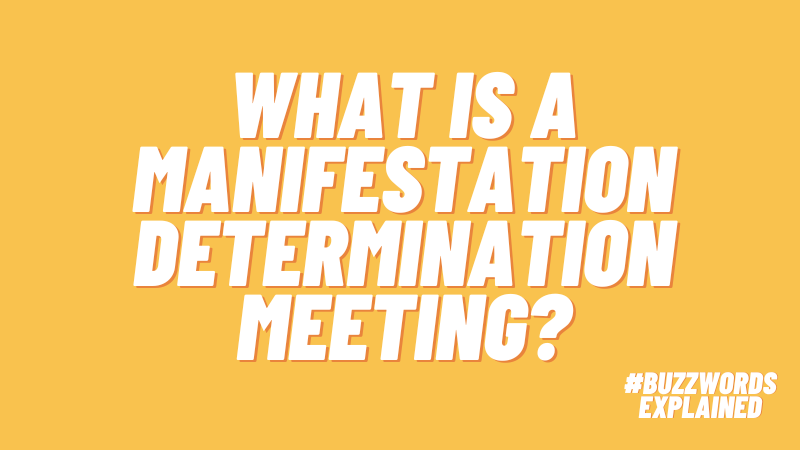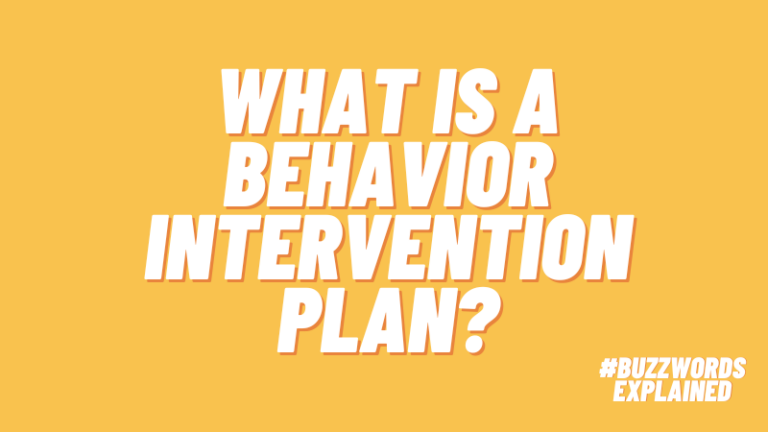Students get into trouble. Students with IEPs get into trouble. When a student with an IEP racks up suspensions, the IEP team has to come together in what’s called a manifestation determination meeting, or MDM.
As a teacher, whether in special education or general education, you may get pulled into an MDM. These meetings can be particularly dicey—emotions are running high all around. So, go in prepared.
What is a manifestation determination?
When a student who has an IEP is disciplined at school and is removed from services—think sent home early or in or out of school suspension—the school has to consider whether or not the student’s behavior was a manifestation of the child’s disability. If the child’s behavior was caused by or directly related to the child’s disability, then it was a manifestation. For example, a child with a learning disability may jump out of their seat and threaten a teacher after they are given an assignment. The student is suspended in accordance with the school discipline policy. In analyzing that incident, the school team needs to think about whether the child’s learning disability either caused or was directly related to their behavior.
There are lots of ways a disability could impact behavior. A child with autism might lack the communication skills to express their wants and needs and use hitting or kicking to gain attention. A child with an emotional disability may lack the self-regulation skills to manage their frustration and lash out as a result. The big picture here is that students with disabilities are subject to the school’s and district’s discipline policies; school administrators can discipline or suspend them. But if they are suspended, the team has to think through what caused the behavior and work to address it so that the student doesn’t miss school because of their disability.
Read more: What Is an IEP meeting?
Read more: Learning Disabilities and Behavior
What is a manifestation determination meeting (MDM)?
A manifestation determination meeting (MDM) is a type of IEP meeting where the team, including the parents of the student, the teacher, a school administrator, and any other relevant people, comes together to discuss:
- Was the behavior caused by or does it have a direct relationship to the child’s disability?
- Was the behavior the result of a failure on the school’s part to implement the IEP?
If the answer is yes to either question, then the behavior is a manifestation of the child’s disability.

Source: SpedTrack
When does a manifestation determination meeting occur?
An MDM is not held after one incident or after the student’s first suspension. An MDM is held within 10 school days if a child with a disability:
- Has been suspended for 10 days in a row, or
- Has been suspended for 10 total days across a school year for similar behaviors
An MDM is also called if the school district is considering expelling the student.
How does the team determine if the behavior is a manifestation of the child’s disability?
Data is at the heart of any IEP team decision, so in an MDM, the team will look at:
- The child’s IEP
- The behavior intervention plan
- School records
- Relevant assessments like a Functional Behavior Assessment or psychological evaluation
- Information from the parent about the child’s disability
Taking all this information into account, the team will decide if the behavior was a manifestation of the child’s disability. In some cases, it will be clear. When a child with oppositional defiant disorder is suspended for escalating refusal to comply with a teacher’s directives until it becomes physical, that’s a clear manifestation of the child’s disability. Other times, it’s not as clear-cut. For example, if a child with ADHD gets into a fight—did their impulsivity play a determining factor?
What happens after a manifestation determination meeting?
There are a variety of next steps that can happen after an MDM. If the team determines that the child’s behavior is a manifestation of the child’s disability, the next step is to decide what to do next. The team may make school-level adjustments, like adjusting the child’s behavior intervention plan. Or they may change the child’s IEP to include additional instruction in communication or self-regulation.
Some other next steps that a team can take include:
- Conducting assessments to get more information about what is causing the student’s behavior (like a Functional Behavior Assessment or formal observations)
- Making changes to the student’s day, adding specially designed services or abbreviating the student’s day to focus on addressing the behavior
What if the student needs an alternative setting?
A student whose behavior is having a significant impact on their learning, and possibly the learning of others, may be best served in an alternative setting. This could be:
- A different school
- A home setting (meeting with a teacher in their home or a library or community setting)
- A virtual setting
- Another setting
A child can be placed in an alternative setting for up to 45 school days if the behavior was a manifestation of the disability and was related to:
- Having a dangerous weapon at school
- Possession, use, or sale of an illegal drug or controlled substance
- Serious bodily injury to others (serious risk of death, disfigurement, permanent injury to a body part or mental abilities)
After the completion of time at the alternative placement, the student can typically return to their home school.
If the suspension is not related to weapons, drugs, or serious harm, the team may still decide that a change in placement is needed for another reason. Perhaps the child has had so many incidences of aggressive behavior that don’t rise to the level of serious injury but could. Or the team determines that another school environment is necessary to support the child’s learning. In this case, the team would determine the placement and adjust the IEP accordingly.
Read more: What Is Least Restrictive Environment?
What happens if the behavior is NOT a manifestation of the child’s disability?
If the behavior is determined not to be related to a child’s disability, then the child can be disciplined like any other student, and this includes expulsion. For example, if a child gets involved in a fight, and the team determines that it is not related to the child’s disability (say, a learning disability), the school team would follow the district’s disciplinary policy.
How do I prepare for a manifestation determination meeting?
If you are involved in an MDM, it’s likely because you have some expertise about the student or the incident. In either case, bring data. If you were involved in the incident, bring a write-up of what happened and any data you can provide (a behavior-tracking sheet, doctor’s report, etc). If you have expertise about the student, bring information that the team can use to talk through whether or not the behavior was a manifestation of the disability and what the school could do next to help the student function better.
What if the school and parents do not agree?
Manifestation determination meetings can get dicey. If the parents do not agree, they can follow procedures to request a mediation or a due process hearing. If the child is in an alternative placement and the parents disagree, the child will stay in that placement until the issue is resolved.
Read more: PACER Center Overview
Resources
Additional reading about managing behavior:
Better Than Carrots or Sticks: Restorative Practices for Positive Classroom Management by Dominique Smith, Douglas Fisher, and Nancy Frey
Motivating Students Who Don’t Care: Proven Strategies To Engage All Learners by Allen Mendler
THE Classroom Management Book by Harry Wong and Rosemary Wong
The Behavior Code: A Practical Guide to Understanding and Teaching the Most Challenging Students by Jessica Minahan and Nancy Rappaport
Plus, download these behavior reflection sheets to use in your classroom.
Have experience with MDMs? Tips to share? Connect on our WeAreTeachers HELPLINE Facebook group.


